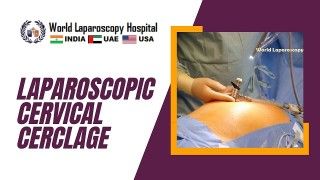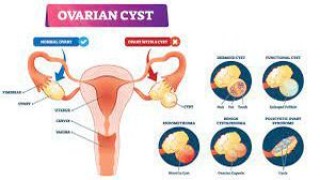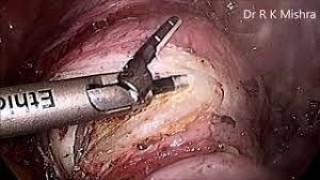Bilateral Ovarian Dermoid Cyst: Managing Symptomatic Dermoid Cysts on Both Ovaries
Add to
Share
1,440 views
Report
2 years ago
Description
Introduction: Bilateral ovarian dermoid cysts, also known as mature cystic teratomas, are a relatively common gynecological condition characterized by the presence of benign cysts on both ovaries. These cysts are composed of different types of tissues, including hair, skin cells, and even teeth. While most dermoid cysts are asymptomatic and discovered incidentally, some can cause symptoms such as pelvic pain, pressure, bloating, and menstrual irregularities. In cases where symptomatic bilateral ovarian dermoid cysts are diagnosed, appropriate management becomes crucial to alleviate symptoms and preserve ovarian function. This article explores the management strategies for bilateral ovarian dermoid cysts, focusing on minimally invasive surgical approaches. Diagnosis and Assessment: The diagnosis of bilateral ovarian dermoid cysts usually involves a combination of medical history evaluation, physical examination, and imaging studies such as transvaginal ultrasound and magnetic resonance imaging (MRI). These diagnostic tools help determine the size, location, and characteristics of the cysts, as well as the presence of any complications. Additionally, assessment of tumor markers, such as CA-125, may be performed to evaluate the possibility of malignancy, although dermoid cysts are typically benign. Treatment Options: The management of bilateral ovarian dermoid cysts depends on various factors, including the patient's age, symptoms, desire for fertility, and the characteristics of the cysts. Conservative management may be considered for asymptomatic cysts or those causing minimal symptoms, with regular monitoring through imaging studies. However, when the cysts become symptomatic or increase in size, surgical intervention is often recommended to alleviate symptoms, prevent complications, and ensure accurate diagnosis by histopathological examination. Minimally Invasive Surgical Approaches: Laparoscopic surgery has emerged as the preferred approach for the management of bilateral ovarian dermoid cysts due to its numerous advantages over traditional open surgery. Laparoscopic techniques allow for smaller incisions, reduced postoperative pain, shorter hospital stays, faster recovery, and improved cosmetic outcomes. The surgery is performed under general anesthesia, and a laparoscope—a thin, flexible tube with a camera—is inserted through a small incision, providing visualization of the cysts and surrounding structures. The surgical procedure involves the removal of the bilateral ovarian dermoid cysts while preserving the healthy ovarian tissue. The cysts are carefully dissected and extracted, taking care to minimize trauma to the ovaries. In cases where the cysts are large or complex, they may be aspirated or decompressed before removal to facilitate the extraction. After complete removal of the cysts, meticulous hemostasis is achieved, and the surgical site is closed. Postoperative Care and Follow-up: Following laparoscopic surgery for bilateral ovarian dermoid cysts, patients are typically monitored in the recovery area before being discharged on the same day or the following day. They are advised to avoid strenuous activities and heavy lifting for a few weeks and to follow the postoperative instructions provided by their healthcare team. Pain management and prophylactic antibiotics may be prescribed to ensure a comfortable recovery. Routine follow-up appointments are scheduled to assess the healing process, monitor for any potential complications, and discuss long-term management strategies, such as contraception and fertility options if desired. Regular imaging studies and tumor marker monitoring may also be recommended to detect any recurrence or new developments. Conclusion: Managing symptomatic bilateral ovarian dermoid cysts requires careful consideration of the patient's symptoms, fertility desires, and the characteristics of the cysts. Minimally invasive laparoscopic surgery has become the preferred approach for the removal of bilateral ovarian dermoid cysts, offering advantages such as smaller incisions, faster recovery, and excellent cosmetic outcomes Moreover, laparoscopic surgery allows for the preservation of healthy ovarian tissue, which is especially important for patients who desire fertility preservation. The procedure involves the careful removal of the cysts while minimizing trauma to the ovaries, ensuring the best possible chance of preserving ovarian function. By opting for laparoscopic surgery, patients with bilateral ovarian dermoid cysts can experience a shorter hospital stay and a faster return to their daily activities compared to traditional open surgery. The smaller incisions result in reduced postoperative pain and discomfort, allowing for a smoother recovery process. Additionally, laparoscopic surgery provides the added benefit of improved cosmetic outcomes. The smaller incisions are less noticeable and result in minimal scarring, enhancing the overall aesthetic appearance. The long-term prognosis for patients undergoing laparoscopic removal of bilateral ovarian dermoid cysts is generally favorable. Most patients experience relief from their symptoms, such as pelvic pain and pressure, and can resume their normal activities without limitations. The preservation of healthy ovarian tissue also ensures the possibility of future fertility and reproductive health. In conclusion, the management of symptomatic bilateral ovarian dermoid cysts involves a comprehensive assessment of the patient's symptoms, fertility desires, and cyst characteristics. Laparoscopic surgery has emerged as a preferred treatment option due to its minimally invasive nature, preservation of ovarian function, faster recovery, and improved cosmetic outcomes. With appropriate surgical intervention and postoperative care, patients can achieve relief from symptoms and enjoy a positive long-term prognosis.
Similar Videos






